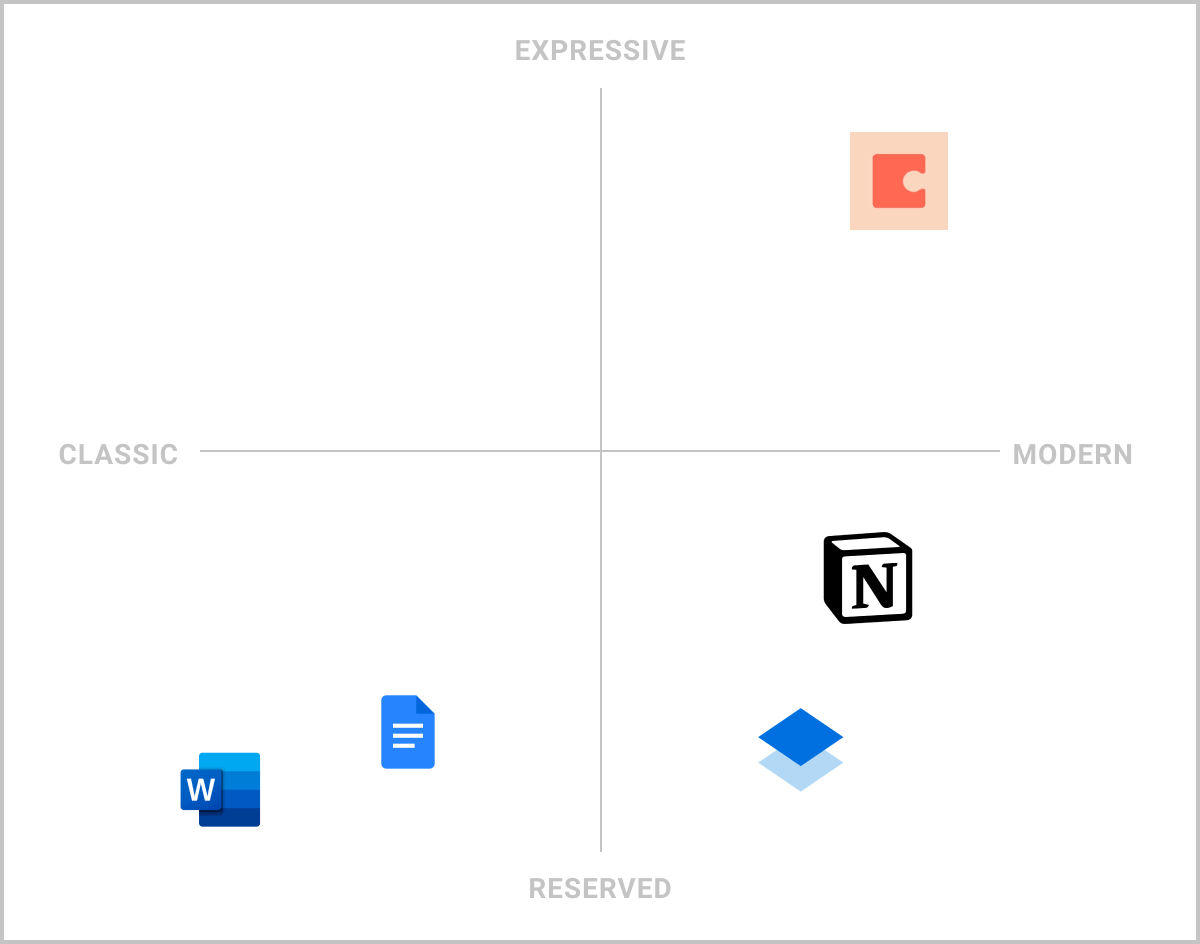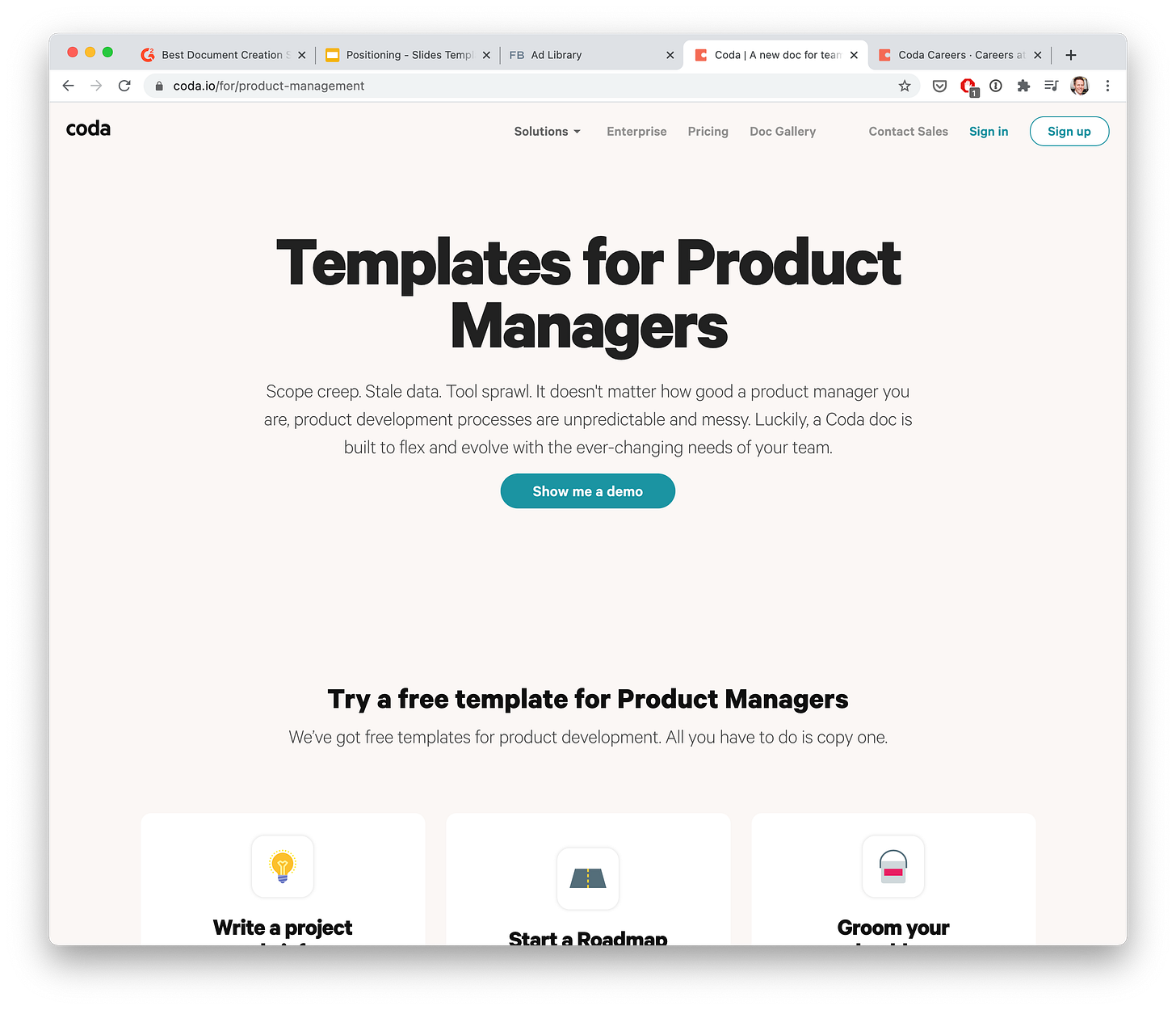Coda — #BrandsWeLove 🏩
Spotlight on Coda's brand strategy
Thank you for being part of this newsletter. Each week, I share playbooks, case studies, stories, and links from inside the startup marketing world. You can click the heart button 💙 above or below to share some love. And you can reach out to me anytime at hello@kevanlee.com. I’d love to hear from you.
Links that are worth your time:
Interesting fact: 30% of executive searches are to re-do a failed executive search
Free Product-Led Growth fundamentals certification 👈 a must for new PLG marketers
Hi there 👋
Constantly I am coming across really cool brands in the tech world, and I’ve been wanting to share these examples with you. Here’s my first crack at it, featuring the Google Docs disruptor, Coda. I’d love any feedback that you have and any ideas for how I could make these more valuable or useful for you. Thanks! You’re the best.
Wishing you a great week,
Kevan
Brand Spotlight: Coda, the rebel document app
👉 Kevan’s brand strategy playbook
My Coda brand journey: I originally heard about Coda a couple years back from a friend at Zapier. My immediate reaction was disinterest and disaffection for yet another collaborative document tool — it was too much. (See below for how thick Coda’s competition is.) I hadn’t given much mind to Coda since then, but the other day a Coda ad popped into my Instagram feed. I was wowed. The ad borrowed creative from the Coda website, seen above: vibrant colors, sharp photography, silly and snarky creative design, and copy that was quick-witted and catchy and a little bit inappropriate.
What a unique brand presence for a document tool, right?
Let’s take a closer look …
About Coda

Coda’s narrative
Your entire team can work in one document. Finally.
Coda is a new type of doc that blends the flexibility of documents, the power of spreadsheets, and the utility of applications into a single new canvas. That’s Coda. It lets non-technical and technical folks alike make a doc as powerful as an app.
—
Coda is a new doc that brings words, data, and teams together. It starts with a blinking cursor on a blank page and can grow as big as your team's ambition. Coda comes with a set of building blocksーlike pages for infinite depth, tables that talk to each other, and buttons that take action inside or outside your docーwhich anyone can combine to make a doc as powerful as an app. People have made Coda docs that do everything from launch products, to scale small businesses, to help them study for tests. What will you Coda?
—
Coda is a new doc that grows with your ideas.
—
The way others describe Coda:
Coda’s brand strategy (according to me)
Brand purpose
Brand purpose tells the story of why you exist in the world. I use a framework from the Ogilvy agency called The Big Ideal, which places your product at the intersection of a cultural tension and your brand’s best self. The Big IdeaL seeks to complete this sentence: “Coda believes the world would be a better place if …”
Alternative:
Coda believes the world would be a better place if our documents worked for us, not against us.
Brand positioning
With positioning, I use a mad-lib, fill-in-the-blanks positioning statement, borrowed from .. well, I’m not sure who came up with it originally. (Arielle Jackson is my favorite source.)
Here’s the template:
For [target customer]
Who [main pain point or challenge]
[Your Company] is a [product category]
That [key solution your company provides].
Unlike [competitors and alternatives],
[Your Company] is [differentiated in these ways].
…
And here’s my take on what this statement might be for Coda:
For digitally-native teams
Who are held back by “dumb” docs
Note: Another path that Coda could choose is to lean into a “collaborative” positioning. Many digitally-native teams feel the pain of working on a project across dozens of docs. With Coda, all that work could be done in a single doc.
Coda is a collaborative document tool
That blends documents, spreadsheets, and apps into one infinitely powerful & flexible tool.
Unlike Google Docs, Dropbox Paper, and MS Word,
Coda makes docs that are as powerful as apps.
Note: There’s likely another set of competitors / alternatives that Coda competes with: The new wave of “smart” all-in-one tools like Notion and Airtable. The key differentiator for Coda vs. Notion / Airtable is likely Coda’s strength as a collaborative project space for teams, whereas Notion is a wiki and Airtable is databases.
Brand personality
“If you met your company at a party, how would you describe it?”
This question proves very helpful for voice and tone. You need look no further than Morning Brew or Wendy’s to see what a strong and unique voice can do for building brand loyalty.
Here’s how I would answer the personality question about Coda’s brand:
Bold
Clever
Dynamic
Coda vs. the competition
Brand matrix
Coda’s main competition is Google Docs, Word, Paper, Quip, Notion — basically anywhere that you create an online, shareable, collaborative doc.
What’s interesting about this space is how traditional the competition can be. Word has been around forever .. it seems like Google Docs has, too. Dropbox Paper and Notion are much more modern in their brand appeal, but I wouldn’t place them as vibrant, bold, or dynamic in the same way that Coda comes across. (There’s definitely room for debate here, when you think about, say, Dropbox’s bold brand refresh from a few years back.)
Side-by-side
Here’s a look at some of these products side-by-side:
For a look at the overall competitive landscape for document creation tools, check out this screenshot from G2 Crowd. It’s a lot!
Coda’s brand in the wild
Social media ads
Video
Website
https://blog.coda.io/ (runs on Medium)
https://coda.io/for/product-management
Thoughts:
Coda has a very rich visual language that ties all their pages and assets together in a really compelling way. The website is simple — a lot of it is built in Coda. (Turns out, pages like Enterprise and Careers don’t really load all that well, which might be a bit of a brand risk assuming people figure out the pages run on Coda.)
Their marketing assets in particular are quite striking and a solid blend of photography, collage, and graphic design. They definitely stand out as high-quality, unique, and original, especially compared to competitors like Google Docs and Word.
3 lessons from Coda’s brand strategy
1. You win with differentiation
A key component of your brand strategy should be considering the rest of the market: alternatives, competitors, consumer trends and more. Please do not create your brand in a vacuum. And please do not create a brand that looks and sounds just like everyone else’s.
This is especially tempting in tech where you see a lot of similar style and design. If you look at Coda’s competition, they’re mostly blue. Coda’s colors and designs stand out, and their key messaging is unique and risky.
(One final note on their main messaging: “Enough of this sheet.” It’s unique and risky, yes, but it also anchors Coda as a spreadsheet alternative, which isn’t exactly true to what it does.)
2. Positioning with more than one path
Often times, you’ll be faced with multiple routes for positioning. In Coda’s case, should they be a powerful, all-in-one doc of the future, or should they be a time-saving collaborative space for teams? They chose the all-in-one doc (I believe). When faced with these types of decisions, it’s important to :
Dig into customer research and get to know the pain points of your customers today. Layer in some market sizing so you’re positioned to attack a problem that has scale to it.
Weigh the future direction of your company. You can have one positioning for today and another for “tomorrow” (whenever your product value matches the ambition).
3. Own an existing category vs. create a new one
There’s a lot of competition in the document space, so it appears that Coda may be on the cusp of some new category creation. After all, they have a document tool that functions as a DIY app. They are half-Google Docs, half-Airtable. They are Notion but not a wiki. There’s really no category that accurately describes what they’re doing right now, so they’re likely to be on a path to making their own.
In the meantime, before that category is created, they have plenty of room to take market share from the existing category. Creating a new category takes time, so while you’re creating, might as well be owning slices of existing categories the best you can.
About this newsletter …
Each week, I share playbooks, case studies, stories, and links from inside the startup marketing world. If you enjoy what’s in this newsletter, you can share some love by hitting the heart button at the top or bottom.💙
About Kevan
I’m a marketing exec who specializes in startup marketing and brand-building. I currently lead the marketing team at Polly (we’re hiring!). I previously built brands at Buffer and Vox.
Not subscribed yet? No worries.
I send a free email every week or so. You can check out the archive, or sign up below:
Already subscribed? You’re in good company …
I’m lucky to count thousands of subscribers as part of this list, including folks from awesome tech companies like these:
Thank you for being here! 🙇♂️















